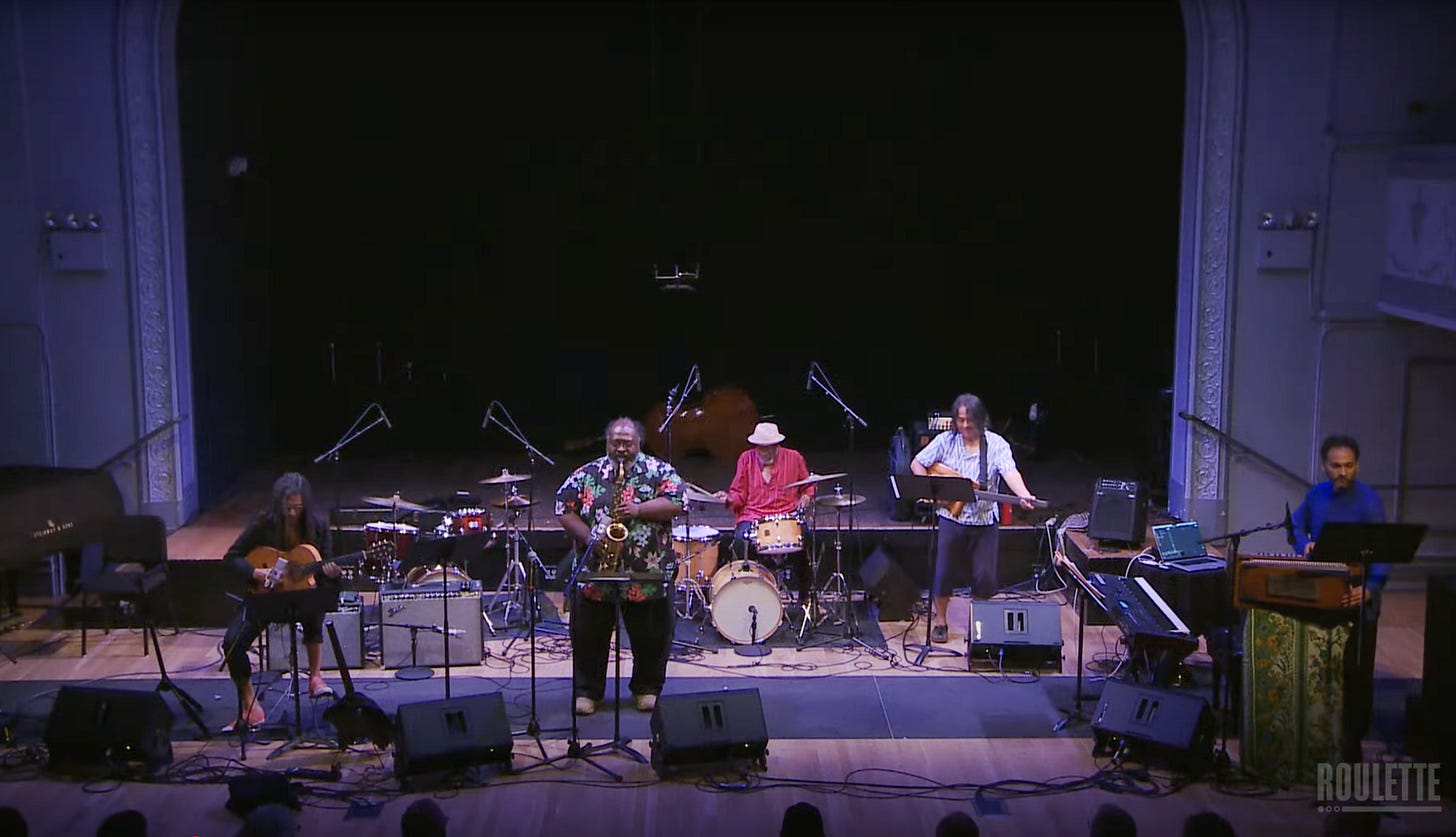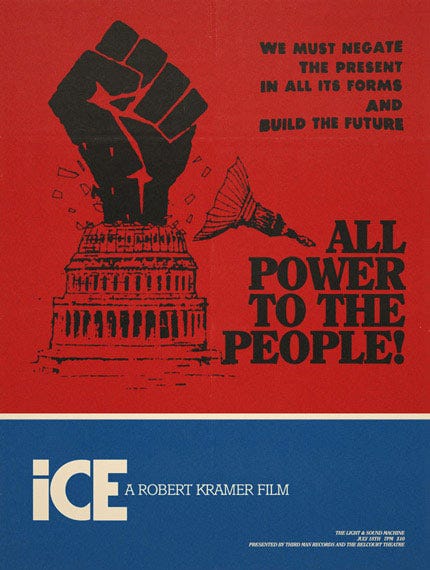The Perfection That Isn't
Vincenzo Latronico, Henry Threadgill's soundtrack to war, cryptic pedagogy with J. Hoberman
At Jacob’s encouragement, I’m trying to be less precious and post more short and bloggier reviews. Here are three from last week. I’d love to hear from you if you have thoughts on any of them.
Perfection by Vincenzo Latronico
A word that appears frequently in Perfection (you’ll hate me for this) is abundance. “Abundance, chiefly of time: with everything being so cheap, there was no need to work long hours, which left them time for other things,” goes one mention. “There wasn’t just an abundance of time in Berlin, but also of space.”
This short book is not, of course, an argument that with a few rollbacks of the regulatory state, the Democrats can perfect America into the utopia that digital nomads enjoyed in Obama-era Berlin. Ostensibly a novella, it reads more like a polemical essay with the touches of fiction you might get in a philosophy paper-style thought experiment. Perfection is mostly a critique, in part of social media-driven lives, making points already made in essays by various Renata Adlers of looking at your phone a lot, and by almost everyone in passing.
It has more interesting things to say about the insatiable emptiness underlying the unrooted lives of bohemian-ish millennials gentrifying various cities over the last decade and half. “The collective upheaval of the twentieth century was over and the vestiges had been translated into the language of individualism – that is, of consumerism. Freedom had turned into abundance.” And even in its most tasteful forms, abundance qua consumption, Latronico believes, will always result in an emptiness that can never be satisfied—in part because of the continual feeling that with infinite choices, something better might be available and being missed. “They couldn’t put their finger on exactly what it was they craved, but they knew it was very different to what they had,” he writes. “They worried they were content merely being contented.”
The protagonist is a non-individuated couple, almost always identified jointly as “Anna and Tom,” and neither they nor their friends have much in the way of personal details beyond the pathological characteristics shared by their milieu. There are few scenes, and fewer idiosyncrasies. Anna and Tom come off as so generationally representative that they can seem idiotic. While reading, I struggled to decide whether the book’s genericized descriptions were a perfect matching of form to the interchangeable lives of the kind of globalized gentrification and Instagrammy aesthetics, or just lazy writing in service of more easily making an argument. The answer is probably “yes and,” though I wonder what a novel swimming in the same waters written by, say, nuance queen Mary Gaitskill might look like. But maybe I should worry about the Perfection that is, rather than the perfection that might be possible.
Be Ever Out: The Music of Henry Threadgill – The Sextett, Make a Move (Night 2)
On a Saturday night after a long, hot day of sand, sea, and lagman, my bicycle carried me from Brighton Beach to Roulette to see the music of Henry Threadgill. I had poorly skimmed the event description, and failed to grasp that Threadgill himself was not playing—neither saxophone, flute, nor hubkaphone. Instead, his compositions were being performed by versions of two of his bands from the 80’s and 90’s, and he was sitting in the back, Homburg hat and big grin affixed to his head.
There were two sets slated, the first of which was Make a Move, the band for what might be my favorite album of his, the harmonium-driven Where’s Your Cup? from 1996. The band had reunited for the performance, save for the original harmonium player Tony Cedras, who died last year. It included Darius Jones, Brandon Ross, and Stomu Takeishi, each of whom would have been a draw for me, even if they had been playing on their own with no Threadgill compositions.
At times the music oozed and slithered, like a puddle exploring and extending its reach. Elsewhere, it rose like a gas, floating ever a bit higher. And then there were the more beat driven moments, when Brandon might have traded his nylon-string classical guitar for a headless electric whose pedal effects verged on an 80’s arena rock sound. Darius managed to sound relaxed, self-assured, and non-abrasive despite taking the band crazy places.
The stylistic variation was matched by the eclectic pants situation onstage: JT Lewis, the drummer, had paired a stripey red button down and Panama hat with Adidas soccer pants. Darius Jones was rocking some of the widest leg pants I’ve seen.
I failed to stay for all of the second Threadgill band, the Sextett, which featured seven instrumentalists, despite its name. During intermission, I learned that the U.S. had begun bombing Iran—a stupid, illegal war begun with little public deliberation or support. About halfway through the set, I gave up on trying to focus on the music. A man sitting in the front row, who had spent the first set taking photos of the band, appeared to be watching Trump’s 10 pm speech on his phone.
Before I left, the mischievous trombonist Frank Lacey, who was somewhat exasperatedly conducting the large group with his instrument while playing, grabbed the mic and noted the event’s title, Be Ever Out. “Out? This music’s not out,” he bellowed, his breaths coming heavy. “This is the hardest music I’ve ever played in my life!”
J. Hoberman Selects: Everything is Now — El Topo on Ice
When he was teaching film at Cooper Union in the 90s, the longtime Village Voice film critic J. Hoberman developed a technique he calls “pedagogical projections”: double, or even triple, bills of movies shows at once through superimposition. All mashed together, these films would necessarily enter a conversation with each other. Hoberman frequently taught “commercial cinema,” and wanted to get through as much material as possible in a short semester. Rocky, he felt, was hard to sit through. So he showed the first three Rocky movies at once, which he found much more compelling, making evident that “they were all the same movie.” Dances With Wolves? The Doors? Both bad. Dances with The Doors? “Now that’s interesting.”
As promotion for his new book —a happily overstuffed history of the avant garde of 60’s New York— Hoberman programmed a week of film selections at Anthology Film Archives culminating in a Sunday night pedagogical pairing of Alejandro Jodorowsky’s El Topo and Ice, both from 1970. Ice is a deliberative and doctrinaire thriller about revolutionaries planning an attack on a fascist U.S. government, which is at war with Mexico. Robert Kramer, a founding member of the New Left film collective The Newsreel, directed the film, which includes audience-addressed slides of sincere lefty sloganeering about false consciousness and revolution interspersed into the narrative almost randomly.
El Topo is a gory acid Western set in the Mexican desert that John Lennon loved so much, he got his manager to give Jodorowsky $1 million to fund his next film. It was, according to Hoberman, perhaps the original midnight movie, and was a massive phenomenon among the young and turned on in New York it ran nightly for six months at the Elgin Theater. “It’s midnight mass at the Elgin,” Glenn O'Brien wrote in his review for the Village Voice. “Jodorowsky is here to confess; the young audience is here for communion.”
To Hoberman both films represent a degradation of the counterculture that he documents in his book. It’s kind of hilarious to use one of your limited nights of programming selections on two movies you dislike. And it’s even funnier to say, essentially: These two stink; so go ahead and watch them both—at the same time! Hoberman assured us that unexpected resonances always emerge during these double-screenings, and sent us off into the experiment with the cryptic prediction that we’d surely see that both these films end the same way.
The exercise turned out to be a silent, widescreen showing of El Topo with Ice superimposed in a small box right at the center of the screen varying between spectral and somewhat visible, with the audio from Ice playing and El Topo’s sound absent. From what I’ve read, Ice—low on exposition and high on discussion— can be challenging to follow even when watched on its own. It seems that viewers don’t usually have as much trouble with El Topo’s simple plot, but with each movie constantly distracting me from the other, I could barely follow either of them.
At times, I would catch random snatches of apparent resonance, like El Topo offering his sexual “leftovers” of a woman to a group of men he calls “dogs” while characters in Ice bark in canine masks (no idea why), and various mentions of Mexico. Some of these connections were mildly amusing, but given how little of either film I could follow, it was hard to experience them as meaningful, rather than just the happenstance of juxtaposition. After witnessing a regular stream of walkouts throughout the first half hour, I entered an interminable delirium of senseless onscreen violence and byzantine, intragroup debate—growing to despise both modes of being. Perhaps this was the point. Two and half hours later, I exited the 60’s appropriately: tired, confused, and a bit older.






